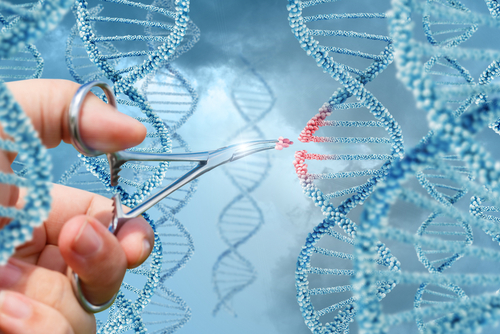How is CRISPR-Cas13a System a potential game changer ?
M3 India Newsdesk Dec 06, 2017
CRISPR-Cas13a is the latest advancement in CRISPR based techniques. It has the potential to become a fast, cheap and accurate diagnostic tool very soon.

CRISPR is an acronym for Clustered Regularly Interspaced Short Palindromic Repeat. This name refers to the unique organization of short, partially palindromic repeated DNA sequences found in the genomes of bacteria and other microorganisms. Furthermore, Cas13a (previously referred to as C2c2), a novel protein, has several unique properties that further expand the CRISPR toolbox.
As per the WHO, 1.5 billion disability-adjusted life years were lost to disease and injury in 2004, and 27% of it was due to infectious diseases. Infectious diseases are still a leading cause of death in the world. In order to decrease morbidity and mortality and to conquer multi-drug resistant pathogens, novel therapeutic approaches and tools are needed. Development of CRISPR as a genome‐editing technique has created a lot of excitement in the field of medical research. Within few years of development, researchers have already applied it across a wide variety of infections caused by pathogenic bacteria, viruses, parasites, and fungi.
What are genome editing and CRISPR-Cas system?
Genome editing
It is also called as gene editing and genome engineering. It allows the genetic material to be added, modified or removed in the genome. It is facilitated by engineered nuclease enzymes also called as molecular scissors. It has the potential to cure diseases by disruption of disease causing genes, insertion of new genes and correction of disease causing mutation.
CRISPR-Cas system
CRISPR or Clustered Regularly Interspaced Short Palindromic Repeats/Crispr Associated Cas enzyme was first discovered by Francisco Mojica in archea and later in bacteria. It is used by bacterial cells for identification and destruction of viral DNA as a form of adaptive immunity. The bacteria use fragments of DNA from invading virus and create segments known as CRISPR arrays. It consists of repeating sequences of genetic code, interrupted by “spacer” sequences which are remnants of genetic code from past invading virus. Spacer sequence acts as a memory for bacteria. When virus attacks again, RNA segments are produced by CRISPR arrays which target the viral DNA/RNA. Then Cas enzymes targets the specific stretch of genetic code and edit the DNA/RNA, disabling the virus. In 2007, this theory was experimentally proved by a team of scientists led by Philippe Horvath.
Common types of Cas enzymes are Cas9, Cpf1, and Cas13a. A brief about them is discussed below.
| Enzyme | Guide RNA | Target | Cleavage mechanism |
|---|---|---|---|
| Cas9 | TracrRNA/crRNA | DNA | Cleaves the target DNA at specific blunt ended double stand breaks |
| Cpf1 | crRNA | DNA | Cleaves the target DNA at specific blunt ended double stand breaks with 5' overhangs |
| Cas13a | crRNA | RNA | Cleavage of specific RNA followed by unspecific RNAse activity |
CRISPR-Cas13a system
In CRISPR-Cas13a system, Cas13a enzyme is associated with CRISPR. It was discovered in 2015 by Shmakov et al. It cuts RNA by two ways. Initially, it cuts the targeted RNA with the CRISPR guide RNA (crRNA) and then Cas13a gets activated when it finds its own target RNA. Activation of Cas13a results in an unspecific destruction of other RNA fragments too.
SHERLOCK (specific high-sensitivity enzymatic reporter unlocking)
A diagnostic tool named “SHERLOCK” (specific high-sensitivity enzymatic reporter unlocking) is developed by using CRISPR-Cas13a system which includes crRNA and a fluorescent RNA probe. Cas13a after getting activated cuts probe RNA along with other RNA. This results in fluorescent signal. Sensitivity was increased by pairing it with RNA amplification. It is a sensitive, rapid and cost-effective method. It cost around $ 0.61/test.
Application of CRISPR-Cas13a system
Detect specific strains of Zika and Dengue
To explore the sensitivity and specificity of SHERLOCK in detecting virus, a lentivirus containing fragments of dengue (DENV) and zika virus (ZIKV) was produced. It detected viral particles upto 2 aM and also successfully distinguished between zika and dengue virus. A paper-based method was developed for detecting zika and dengue virus by lyophilizing the reagents and rehydrating them into a spot on the paper. However, the detection limit was reduced by 1 log10 (20 aM) with a low fluorescent signal for ZIKV and high background signal for DENV. It was also detected on glass fiber paper. ZIKV was also detectable in clinical isolates at a concentration of 1.25 × 103 copies/mL (2.1 aM), it was verified by qPCR.
Distinguish pathogenic bacteria
It also detected bacterial pathogens by targeting v3 hyper variable region of 16s rRNA gene, which distinguishes all bacterial species to the genus level. It successfully detected Escherichia coli and Pseudomonas aeruginosa. It also distinguished isolates of k. pneumoniae with different resistance genes, either carbapenemase or New Delhi metallo-beta-lactamase-1.
Genotype human DNA
SHERLOCK helps in detecting single nucleotide polymorphisms (SNPs). They are the most common and simplest type of genetic variation in the human genome. It is able to detect SNP-containing alleles in the clinically relevant range, at levels as low as 0.1% of background DNA.
Identify cell-free tumor DNA mutations
SHERLOCK successfully demonstrated detection of two cancer mutations, EGFR L858R and BRAF V600E in mock cfDNA samples with allelic fractions as low as 0.1%.
SHERLOCK is a sensitive, rapid and cost-effective method. Its sensitivity is approximately 1000 times more than other methods and it is cost effective with a cost of around $ 0.61/test. Its ability to differentiate single nucleotide polymorphisms is a great achievement for cheap diagnostic as many mutations in humans or pathogens that affect humans are a single base.
CRISPR-Cas13a system is a new concept so new challenges can be seen in academic and laboratory settings. In short, the Cas13a molecule brings a much anticipated element of diversity to the CRISPR toolbox and will continue to expand the applications of CRISPR.
-
Exclusive Write-ups & Webinars by KOLs
-
Daily Quiz by specialty
-
Paid Market Research Surveys
-
Case discussions, News & Journals' summaries